Fine Art. FAKES.
For many years The Virgin and Child with an Angel was prized as Francesco Francia’s earliest known dated painting (faintly signed and dated 1490) and for representing, in the chalice held by the angel, the only known example of the type of object Francia may have produced during his presumed earlier career as a goldsmith. But in 1954 an apparently identical version surfaced in a London auction. A thorough investigation of both paintings was undertaken to determine which was Francia’s original.
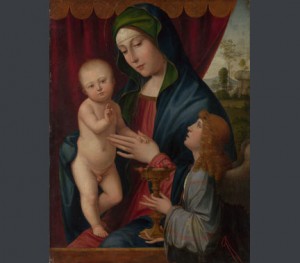
After Francesco Francia, The Virgin and Child with an Angel, probably second half of the 19th century
Side-by-side investigation
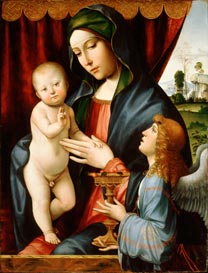
Francesco Francia, ‘The Virgin and Child with an Angel’, about 1490 © Carnegie Museum of Art, Pittsburgh
In 1955 examination of the National Gallery painting found the wood panel,ground and paint layers to be reasonably consistent with 15th-century practice, although it was noted that the gessoground was a remarkably bright white. The imprimatura was a pinkish-brown. Although most unusual in a painting of 1490, a similar imprimatura had also been observed in a slightly later painting by Francia in the Gallery’s collection, The Virgin and Child with Two Saints, of about 1500–10. (The imprimatura on the newly discovered painting was later revealed to be a characteristic off-white colour.)
A comparison of the X-ray images taken of both paintings showed the Gallery’s version to be rather thinly painted, in contrast to the more traditional, layered build-up of paint evident in the other picture.Microscopic examination of the former’s craquelure aroused even greater suspicion: the ‘cracks’ were painted on the surface of the painting to mimic the appearance of a naturally aged paint surface.
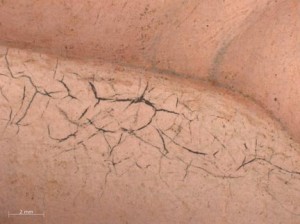
Photomicrograph detail, showing ‘faked’ craquelure painted on the surface of ‘The Virgin and Child with an Angel’, National Gallery
In 1955 the National Gallery acknowledged that its painting was probably a 19th-century fake and that the newly rediscovered painting, today in the collection of the Carnegie Museum of Art, Pittsburgh, was Francia’s original.
The case reopened
In 2009 the Gallery painting and its ‘twin’ were investigated once again. Existing evidence was re-examined and new analyses undertaken in an attempt to resolve outstanding queries. X-radiographs taken of the Gallery’s painting in 1955 showed that channels left by woodworms, quite common in Italian panels, had been filled with X-ray opaque material. But the lack of exit holes on the back of the panel indicated that the channels had been filled from the front before the ground and paint layers had been applied. This suggested the painting had been made on a ‘recycled’ old panel, planed down to receive a new painting – a phenomenon frequently encountered in paintings deliberately made to appear deceptively old.
The unusual pink imprimatura was also reconsidered. The painting by Francia believed to have a comparable imprimatura (‘The Virgin and Child with Two Saints’) had actually been transferred to a new panel probably in the 18th century, and the pinkish imprimatura applied as part of that process. As it was not original to Francia’s painting, it provided no justification for the odd imprimatura of the London ‘Virgin and Child with an Angel’.
New analysis also revealed pigments that would be unusual, if not impossible, for an authentic 15th-century painting. A sample taken of the red curtain, examined microscopically and with HPLC, was found to contain the red lake pigment madder, of a type most probably manufactured in the 19th century. Other anachronistic pigments identified include chrome yellow, a synthetic pigment commercially available only from 1818.
Drawings underneath… and on top?
Infrared reflectography revealed the London painting to have an unusually detailed underdrawing. Apparently executed in graphite pencil and based on a transfer from a pricked cartoon, the underdrawing is more reminiscent of much later, finished drawings than authentic Renaissance underdrawings.
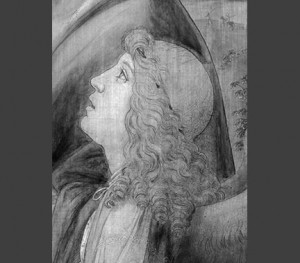
Infrared reflectogram detail, showing underdrawn head of the angel at lower right, ‘The Virgin and Child with an Angel’, National Gallery
In comparison, underdrawing in the Pittsburgh painting is executed in a liquid medium with a brush, and combines careful outlines with areas of diagonal hatching to indicate shadows. Although the Pittsburgh painting follows the underdrawn design quite faithfully, infrared and X-ray images show that the artist made minor adjustments as the work progressed – further indication that this painting is the original.
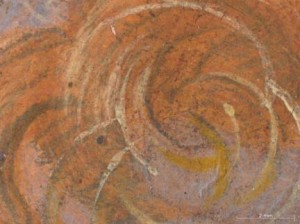
Photomicrograph detail, showing graphite markings applied to the surface of ‘The Virgin and Child with an Angel’, National Gallery
Finally, microscopic examination of the London painting showed pencil lines applied on top of the paint in areas of fine detail. This technique is uncharacteristic of Renaissance paintings (no such pencil marks were found in the Pittsburgh painting), but is a feature encountered in some 19th- and 20th-century paintings.
Marjorie E. Wieseman is Curator of Dutch paintings at National Gallery. This material was published on 30 June 2010 to coincide with the exhibition Close Examination: Fakes, Mistakes and Discoveries
Further reading
A. Roy and G. Mancini, ‘“The Virgin and Child with an Angel”, after Francia: A history of error’, ‘The National Gallery Technical Bulletin’ 31, 2010, pp. 64–77
M.E. Wieseman, ‘A Closer Look: Deceptions and Discoveries’, London 2010, pp. 39–41
Source: nationalgallery.org.uk


This Post Has 0 Comments